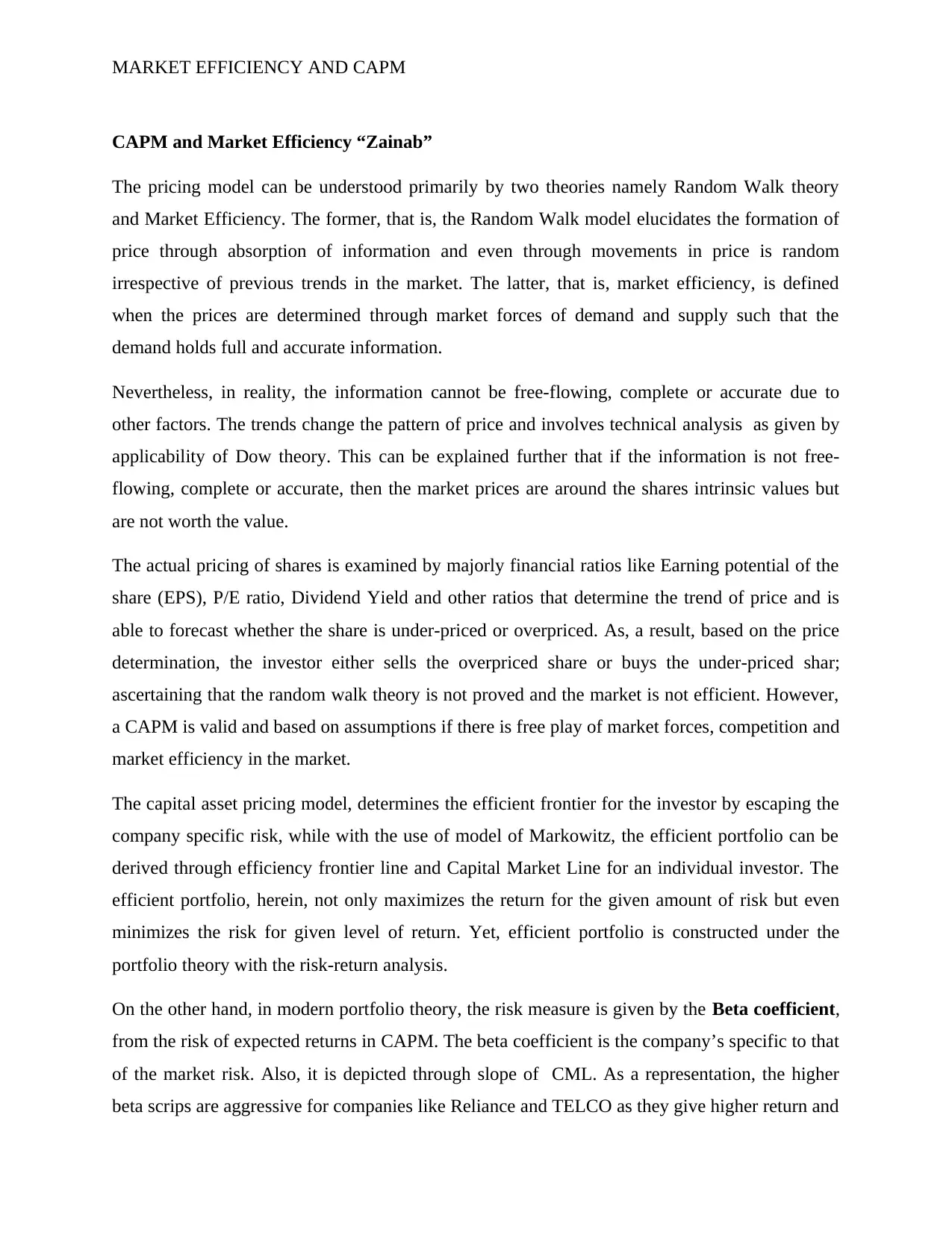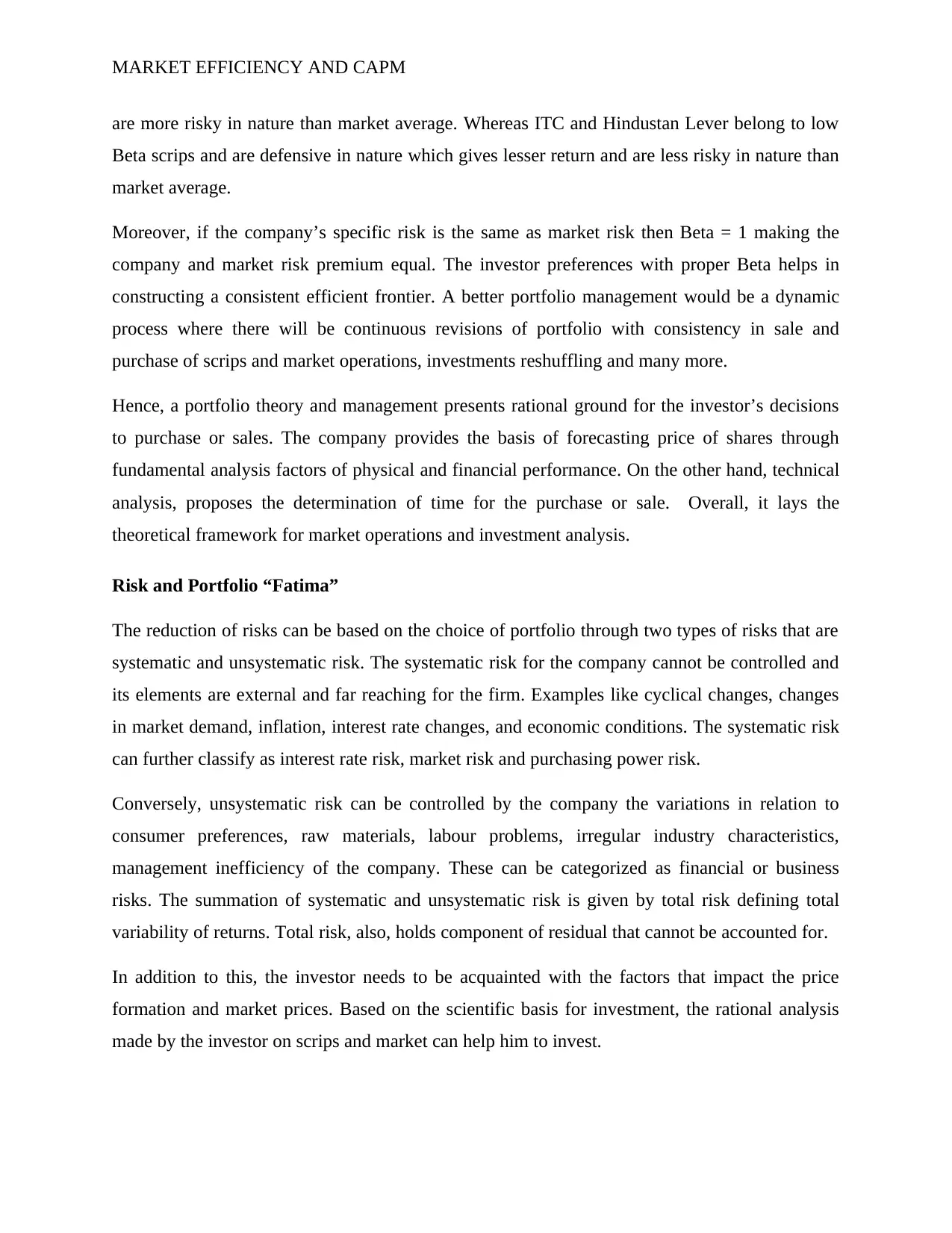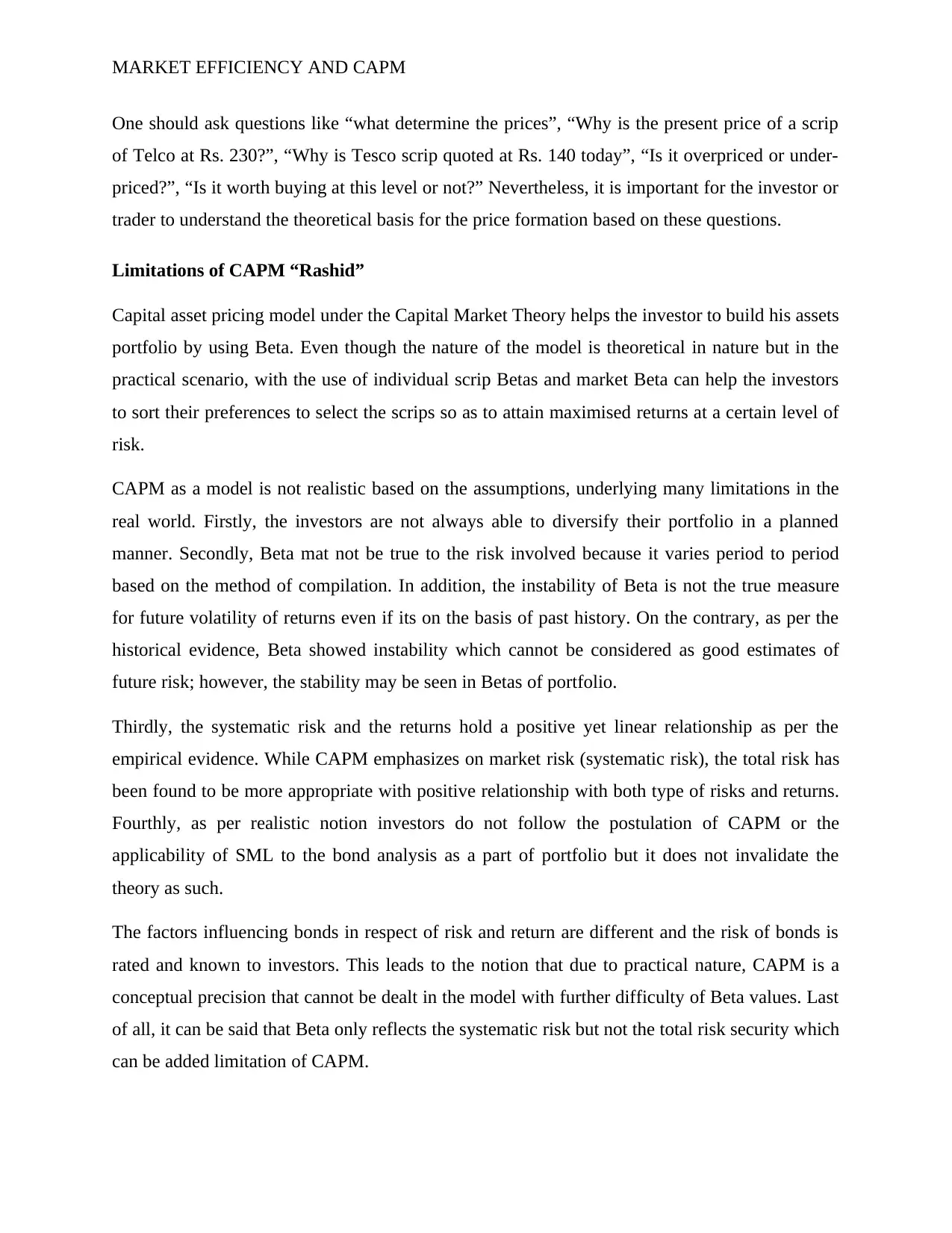Market Efficiency and CAPM: A Comprehensive Financial Report
VerifiedAdded on 2023/06/03
|4
|1360
|456
Report
AI Summary
This report delves into the concepts of market efficiency and the Capital Asset Pricing Model (CAPM), examining how market prices are formed and the role of information in determining share values. It explores the Random Walk theory and its implications for investment strategies. The report discuss...

Running head: MARKET EFFICIENCY AND CAPM
Market Efficiency and Limitations of CAPM
Name of the Student:
Name of the University:
Author’s Note:
Market Efficiency and Limitations of CAPM
Name of the Student:
Name of the University:
Author’s Note:
Paraphrase This Document
Need a fresh take? Get an instant paraphrase of this document with our AI Paraphraser

MARKET EFFICIENCY AND CAPM
CAPM and Market Efficiency “Zainab”
The pricing model can be understood primarily by two theories namely Random Walk theory
and Market Efficiency. The former, that is, the Random Walk model elucidates the formation of
price through absorption of information and even through movements in price is random
irrespective of previous trends in the market. The latter, that is, market efficiency, is defined
when the prices are determined through market forces of demand and supply such that the
demand holds full and accurate information.
Nevertheless, in reality, the information cannot be free-flowing, complete or accurate due to
other factors. The trends change the pattern of price and involves technical analysis as given by
applicability of Dow theory. This can be explained further that if the information is not free-
flowing, complete or accurate, then the market prices are around the shares intrinsic values but
are not worth the value.
The actual pricing of shares is examined by majorly financial ratios like Earning potential of the
share (EPS), P/E ratio, Dividend Yield and other ratios that determine the trend of price and is
able to forecast whether the share is under-priced or overpriced. As, a result, based on the price
determination, the investor either sells the overpriced share or buys the under-priced shar;
ascertaining that the random walk theory is not proved and the market is not efficient. However,
a CAPM is valid and based on assumptions if there is free play of market forces, competition and
market efficiency in the market.
The capital asset pricing model, determines the efficient frontier for the investor by escaping the
company specific risk, while with the use of model of Markowitz, the efficient portfolio can be
derived through efficiency frontier line and Capital Market Line for an individual investor. The
efficient portfolio, herein, not only maximizes the return for the given amount of risk but even
minimizes the risk for given level of return. Yet, efficient portfolio is constructed under the
portfolio theory with the risk-return analysis.
On the other hand, in modern portfolio theory, the risk measure is given by the Beta coefficient,
from the risk of expected returns in CAPM. The beta coefficient is the company’s specific to that
of the market risk. Also, it is depicted through slope of CML. As a representation, the higher
beta scrips are aggressive for companies like Reliance and TELCO as they give higher return and
CAPM and Market Efficiency “Zainab”
The pricing model can be understood primarily by two theories namely Random Walk theory
and Market Efficiency. The former, that is, the Random Walk model elucidates the formation of
price through absorption of information and even through movements in price is random
irrespective of previous trends in the market. The latter, that is, market efficiency, is defined
when the prices are determined through market forces of demand and supply such that the
demand holds full and accurate information.
Nevertheless, in reality, the information cannot be free-flowing, complete or accurate due to
other factors. The trends change the pattern of price and involves technical analysis as given by
applicability of Dow theory. This can be explained further that if the information is not free-
flowing, complete or accurate, then the market prices are around the shares intrinsic values but
are not worth the value.
The actual pricing of shares is examined by majorly financial ratios like Earning potential of the
share (EPS), P/E ratio, Dividend Yield and other ratios that determine the trend of price and is
able to forecast whether the share is under-priced or overpriced. As, a result, based on the price
determination, the investor either sells the overpriced share or buys the under-priced shar;
ascertaining that the random walk theory is not proved and the market is not efficient. However,
a CAPM is valid and based on assumptions if there is free play of market forces, competition and
market efficiency in the market.
The capital asset pricing model, determines the efficient frontier for the investor by escaping the
company specific risk, while with the use of model of Markowitz, the efficient portfolio can be
derived through efficiency frontier line and Capital Market Line for an individual investor. The
efficient portfolio, herein, not only maximizes the return for the given amount of risk but even
minimizes the risk for given level of return. Yet, efficient portfolio is constructed under the
portfolio theory with the risk-return analysis.
On the other hand, in modern portfolio theory, the risk measure is given by the Beta coefficient,
from the risk of expected returns in CAPM. The beta coefficient is the company’s specific to that
of the market risk. Also, it is depicted through slope of CML. As a representation, the higher
beta scrips are aggressive for companies like Reliance and TELCO as they give higher return and

MARKET EFFICIENCY AND CAPM
are more risky in nature than market average. Whereas ITC and Hindustan Lever belong to low
Beta scrips and are defensive in nature which gives lesser return and are less risky in nature than
market average.
Moreover, if the company’s specific risk is the same as market risk then Beta = 1 making the
company and market risk premium equal. The investor preferences with proper Beta helps in
constructing a consistent efficient frontier. A better portfolio management would be a dynamic
process where there will be continuous revisions of portfolio with consistency in sale and
purchase of scrips and market operations, investments reshuffling and many more.
Hence, a portfolio theory and management presents rational ground for the investor’s decisions
to purchase or sales. The company provides the basis of forecasting price of shares through
fundamental analysis factors of physical and financial performance. On the other hand, technical
analysis, proposes the determination of time for the purchase or sale. Overall, it lays the
theoretical framework for market operations and investment analysis.
Risk and Portfolio “Fatima”
The reduction of risks can be based on the choice of portfolio through two types of risks that are
systematic and unsystematic risk. The systematic risk for the company cannot be controlled and
its elements are external and far reaching for the firm. Examples like cyclical changes, changes
in market demand, inflation, interest rate changes, and economic conditions. The systematic risk
can further classify as interest rate risk, market risk and purchasing power risk.
Conversely, unsystematic risk can be controlled by the company the variations in relation to
consumer preferences, raw materials, labour problems, irregular industry characteristics,
management inefficiency of the company. These can be categorized as financial or business
risks. The summation of systematic and unsystematic risk is given by total risk defining total
variability of returns. Total risk, also, holds component of residual that cannot be accounted for.
In addition to this, the investor needs to be acquainted with the factors that impact the price
formation and market prices. Based on the scientific basis for investment, the rational analysis
made by the investor on scrips and market can help him to invest.
are more risky in nature than market average. Whereas ITC and Hindustan Lever belong to low
Beta scrips and are defensive in nature which gives lesser return and are less risky in nature than
market average.
Moreover, if the company’s specific risk is the same as market risk then Beta = 1 making the
company and market risk premium equal. The investor preferences with proper Beta helps in
constructing a consistent efficient frontier. A better portfolio management would be a dynamic
process where there will be continuous revisions of portfolio with consistency in sale and
purchase of scrips and market operations, investments reshuffling and many more.
Hence, a portfolio theory and management presents rational ground for the investor’s decisions
to purchase or sales. The company provides the basis of forecasting price of shares through
fundamental analysis factors of physical and financial performance. On the other hand, technical
analysis, proposes the determination of time for the purchase or sale. Overall, it lays the
theoretical framework for market operations and investment analysis.
Risk and Portfolio “Fatima”
The reduction of risks can be based on the choice of portfolio through two types of risks that are
systematic and unsystematic risk. The systematic risk for the company cannot be controlled and
its elements are external and far reaching for the firm. Examples like cyclical changes, changes
in market demand, inflation, interest rate changes, and economic conditions. The systematic risk
can further classify as interest rate risk, market risk and purchasing power risk.
Conversely, unsystematic risk can be controlled by the company the variations in relation to
consumer preferences, raw materials, labour problems, irregular industry characteristics,
management inefficiency of the company. These can be categorized as financial or business
risks. The summation of systematic and unsystematic risk is given by total risk defining total
variability of returns. Total risk, also, holds component of residual that cannot be accounted for.
In addition to this, the investor needs to be acquainted with the factors that impact the price
formation and market prices. Based on the scientific basis for investment, the rational analysis
made by the investor on scrips and market can help him to invest.
⊘ This is a preview!⊘
Do you want full access?
Subscribe today to unlock all pages.

Trusted by 1+ million students worldwide

MARKET EFFICIENCY AND CAPM
One should ask questions like “what determine the prices”, “Why is the present price of a scrip
of Telco at Rs. 230?”, “Why is Tesco scrip quoted at Rs. 140 today”, “Is it overpriced or under-
priced?”, “Is it worth buying at this level or not?” Nevertheless, it is important for the investor or
trader to understand the theoretical basis for the price formation based on these questions.
Limitations of CAPM “Rashid”
Capital asset pricing model under the Capital Market Theory helps the investor to build his assets
portfolio by using Beta. Even though the nature of the model is theoretical in nature but in the
practical scenario, with the use of individual scrip Betas and market Beta can help the investors
to sort their preferences to select the scrips so as to attain maximised returns at a certain level of
risk.
CAPM as a model is not realistic based on the assumptions, underlying many limitations in the
real world. Firstly, the investors are not always able to diversify their portfolio in a planned
manner. Secondly, Beta mat not be true to the risk involved because it varies period to period
based on the method of compilation. In addition, the instability of Beta is not the true measure
for future volatility of returns even if its on the basis of past history. On the contrary, as per the
historical evidence, Beta showed instability which cannot be considered as good estimates of
future risk; however, the stability may be seen in Betas of portfolio.
Thirdly, the systematic risk and the returns hold a positive yet linear relationship as per the
empirical evidence. While CAPM emphasizes on market risk (systematic risk), the total risk has
been found to be more appropriate with positive relationship with both type of risks and returns.
Fourthly, as per realistic notion investors do not follow the postulation of CAPM or the
applicability of SML to the bond analysis as a part of portfolio but it does not invalidate the
theory as such.
The factors influencing bonds in respect of risk and return are different and the risk of bonds is
rated and known to investors. This leads to the notion that due to practical nature, CAPM is a
conceptual precision that cannot be dealt in the model with further difficulty of Beta values. Last
of all, it can be said that Beta only reflects the systematic risk but not the total risk security which
can be added limitation of CAPM.
One should ask questions like “what determine the prices”, “Why is the present price of a scrip
of Telco at Rs. 230?”, “Why is Tesco scrip quoted at Rs. 140 today”, “Is it overpriced or under-
priced?”, “Is it worth buying at this level or not?” Nevertheless, it is important for the investor or
trader to understand the theoretical basis for the price formation based on these questions.
Limitations of CAPM “Rashid”
Capital asset pricing model under the Capital Market Theory helps the investor to build his assets
portfolio by using Beta. Even though the nature of the model is theoretical in nature but in the
practical scenario, with the use of individual scrip Betas and market Beta can help the investors
to sort their preferences to select the scrips so as to attain maximised returns at a certain level of
risk.
CAPM as a model is not realistic based on the assumptions, underlying many limitations in the
real world. Firstly, the investors are not always able to diversify their portfolio in a planned
manner. Secondly, Beta mat not be true to the risk involved because it varies period to period
based on the method of compilation. In addition, the instability of Beta is not the true measure
for future volatility of returns even if its on the basis of past history. On the contrary, as per the
historical evidence, Beta showed instability which cannot be considered as good estimates of
future risk; however, the stability may be seen in Betas of portfolio.
Thirdly, the systematic risk and the returns hold a positive yet linear relationship as per the
empirical evidence. While CAPM emphasizes on market risk (systematic risk), the total risk has
been found to be more appropriate with positive relationship with both type of risks and returns.
Fourthly, as per realistic notion investors do not follow the postulation of CAPM or the
applicability of SML to the bond analysis as a part of portfolio but it does not invalidate the
theory as such.
The factors influencing bonds in respect of risk and return are different and the risk of bonds is
rated and known to investors. This leads to the notion that due to practical nature, CAPM is a
conceptual precision that cannot be dealt in the model with further difficulty of Beta values. Last
of all, it can be said that Beta only reflects the systematic risk but not the total risk security which
can be added limitation of CAPM.
1 out of 4
Related Documents
Your All-in-One AI-Powered Toolkit for Academic Success.
+13062052269
info@desklib.com
Available 24*7 on WhatsApp / Email
![[object Object]](/_next/static/media/star-bottom.7253800d.svg)
Unlock your academic potential
© 2024 | Zucol Services PVT LTD | All rights reserved.




